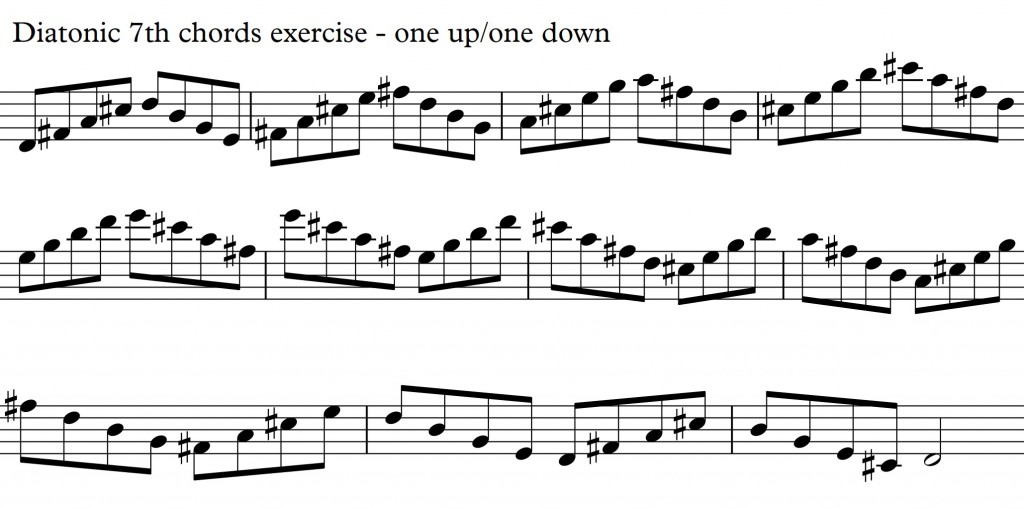In this video lesson I talk about the different 7th chords on a II-V-I in Dmajor.
I start with the scale of Dmajor, the scale has two sharps with the notes D-E-F#-G-A-B-C#.
I strongly recommend that you learn the scale, the notes and how it sounds on the saxophone.
Here is an exercise how to learn the scale even better.
The exercise start on the low D going to the high E, going back down to the low C# and ending on the low D.
This extends the exercise to almost the whole range of the saxophone and you develop your technique likewise. You can put any form to your exercises but make sure the meaning of the exercise stays intact, technique, speed, extremities of the horn etc.
This lesson will further discuss the diatonic 7th chords on a II-V-I in Dmajor. On each note of the Dmajor scale you have a chord that consist of 4 notes. I will play those chords.
Dmaj7 on the D – D-F#-A-C#, Em7 on the E – E-G-B-D, F#m7 on F# – F#-A-C-E, Gmaj7 on G – G-B-D-F#, A7 on A – A-C#-E-G, Bm7 on B – B-D-F#-A, C#ø7 on C# – C#-E-G-B.
All these 7th chords are very important tools to use in a solo, but also gives you an overview of the scale and the functions.
I will now play an exercise to get to learn the diatonic 7th chords better.
This exercise have a written out rhythm in it and is fitting in a 4-bar period.
You can make up any exercise in this matter pplaying the 7th chords going up or down, or both as long as the exercise fits whatever purpose you want to achieve.
The next exercise is the 7th chords going up but with no break in between, big breath!
This exercise you can easily play as 8th notes as here, but you can also play it as 16th notes with the metronome on the 1 of the bar, training the 7th chords and your timing.
You can also play the chords going down instead of up.
You can also try this exercise playing one chord up – one chord down. Looks like this.
Ill play this exercise faster to give an example of that you need to know this material very well.
The II-V-I in Dmajor have three different chords Em7 – A7 – Dmaj7.
Out of these chords you can find other diatonic 7th chords which also spells out the function of the II-V-I.
I extend the chords of the I-V-I to Em11 – A9 – Dmaj9
The first chords is Em11.
On the Em11 – E-G-B-D-F#-A, you find three different 7th chords.
On the first degree of the Em11 you will of course find the Em7 – E-G-B-D.
On the third degree of the Em11 you have a Gmaj7 chord – G-B-D-F# and on the 5th degree of the Em11 you have a Bm7 – B-D-F#-A.
On the dominant function of the II-V-I – the V, A9 – A-C#-E-G-B, we have two 7th chords, the A7 – A-C#-E-G and the C#ø7 – C#-E-G-B.
On the dominant function, A9, and on our tonic function, Dmaj9, we only have twho chords because if we get higher we get to the fourth degree of the chord which clashes very much with the third degree of the A9 – a D against the C# and the Dmaj9 – a G against a F#.
The root, our tonic function Dmaj9 – D-F#-A-C#-E we also have two chords, Dmaj7 – D-F#-A-C# and F#m7 – F#-A-C#-E.
Get to know these chords and functions well, they are very valuable in your soloing, transcribing solos of others and generally understanding music and what´s happening.
Fx. you dont always have to play up or down the Dmaj7 chord on Dmaj7 but you can easily use the F#m7 chord up or down. On the A7 you can use the A7 of course but also consider the C#ø7 chord which gives another sound. On the Em7 chord you even have three possibilities which are the Em7, the Gmaj7 and the Bm7 chord, check them all out.
Example 1 – II-V-I in Dmajor.
I start on the high D going down the Em7 chord, jumping up to the C#, going down the scale jumping down to the middle B playing up the Bm7 chord dragging over the Em7 (Bm7 chord) over the barline to A7 playing a small bebop lick going down the A7 scale to the C# of the Dmajor running up the C#ø7 chord of the A7 on the Dmaj7 approaching via the B+D, on top the C# going down the Dmaj7 7th chord ending on the C#.
Example 2 – II-V-I in Dmajor.
Starting on a Em11 chord in triplets going up to the A approaching the G through the A+F#, further approaching the F# on the A7 via G+E, jumping down to the low C# running up the C#ø7 chord ending high on a D+F# approaching the E, goiong down the scale to hit the C# on the Dmaj7 chord, jumping down to the D to play the Dmaj9 chord up approaching the D via E+C#, running from D up the Dmaj9 chord.
hint: check my video on diatonic approach notes here
Example 3 – II-V-I in Dmajor.
Going up the Gmaj7 chord of the Em9 approaching, through the F#+A, the G, going down the scale and via the D+B approaching the C# of the A9, playing the whole A9 chord in a triplet figure up to the high D of the Dmaj7, further up to the high F# going down the scale to the C#, jumping down playing the F#m7 up jumping to the A using a Coltrane line 5-3-2-1 on the Dmaj7 ending on the C#.
I hope you enjoyed the video and hope to see you back soon.












